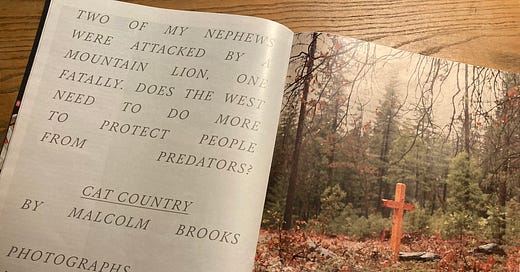So for me personally, December 31, 2024, turned out to be the finish line for more than just a particularly surreal calendar year.
In the aftermath of the mountain lion attack on my nephews last spring, I spent a tremendous amount of time and energy researching and writing a piece on the incident and wildlife management in general for the New York Times Magazine. Dozens of interviews with people who work in the field in one capacity or another, dozens of hours reading through books and newspaper archives and scientific papers, all in the effort to wrap my head around the macro dimensions of an incident that at the micro level landed on my family like a grenade.
By early December the story was scheduled to run in print on Sunday, January 5th, a date I fixed in my head as a sort of anticipatory landing strip for my own ability to see this long and at times nerve-wracking mission finally accomplished. So it came as quite a shock to wake up New Year’s Eve morning to a barrage of emails and text messages, alerting me to the fact that the plane had actually blown in early—the piece was already running in the Times’ online newsfeed. Unexpected, for sure, but on the last day of a particularly fraught year, it quickly came to seem fitting.
I learned a lot in the course of navigating the backdrop and context around what happened to my nephews, and the ongoing ripple effects through family and community. But one thing stands out—the folly of treating any single wildlands or wildlife issue like some extraneous, disconnected piece of an otherwise intact puzzle. In reality, nothing in ecology happens in a vacuum. It’s a total system, with major complexities that require flexibility and adaptability on the part of us, the modern humans who now have to grapple with the startling success of our own species, and the responsibility that comes along with it.
A big part of that is sustainable balance with the natural world, because that’s still the house we live in—all 8.5 billion of us, whether any one of us realizes it in any given moment.
At the same time, there’s no hard and fast rulebook, no tablets handed down from on high—just an ongoing learning process, full of trial-and-error and second-guesses and course-corrections. Once upon a time, damming major waterways and snuffing every forest fire with extreme prejudice actually qualified as conventional wisdom; nowadays we’re tearing out dams, and wishing we’d let the woods burn in a more punctuated fashion, before the mounting fuel load made all-out catastrophe inevitable.
So live and learn. In the case of large carnivores at the top of food chain, push-and-pull happens all the time, for reasons known and no doubt unknown. Increasingly in California, an exploding black bear population appears to have contributed to the state’s dramatically declining deer herd (one study demonstrated that Sierra Nevada mule deer fawns are six times more likely to die from black bear predation than any other cause—while another concluded that the state’s bears force mountain lions off seventy percent of their own deer kills, causing the lions to have to take still more deer in order to eat). Why did the black bear population expand so rapidly in the first place? At least partially because a ban on the use of hounds for bear hunting in 2012 caused the annual take by human hunters to plummet. And so it goes, with isolated management decisions triggering an unforeseen cascade of consequences throughout the entire system.
What follows is a series of links for anyone wanting to learn more about both the event with my nephews, and the bigger-picture dilemmas that professional wildlife managers face in the current era. I hope they help to shed some rational light on what can be perceived as an entire range of extremely contentious issues, but what in reality represents a single issue—the need to consider the natural world around us, and the creatures we share the place with, as one complete puzzle, with no separate pieces.
New Yorker/California Bear Boom





There really are no words to express my deep sympathy for you and your family. Thank you for sharing all of this. The article you wrote was tragic, telling, and informative. Wishing you all the best.